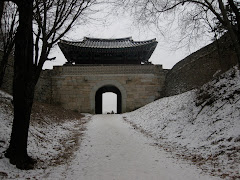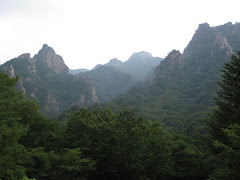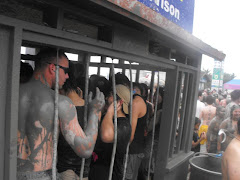Thursday, July 30, 2009
KOREAN Observations
Tuesday, July 28, 2009
KOREA Week XIII Review
Monday, July 20, 2009
KOREA Week XII Review
Wednesday, July 15, 2009
KOREA Week XI Review
Weds, July 15, 2009 at 11:43pm
MUD FEST. Three words: Muddy, Wet, Muddy.
Despite this, it was a really good time and every visitor to Korea should visit the Mud Fest at least once. No exaggeration; there was mud everywhere. After only 5 minutes at the festival, it was near impossible not to have mud on you or your clothing. There was mud wrestling in a giant mud filled pool, there were mud slides, women (both foreign and Korean) dressed in bikinis, and paint brushes to help apply mud thoroughly to oneself, friends, and any stranger in need of some. Half naked bodies covered from head to toe in brown, silky mud ran through the busy streets; perhaps chasing others, or in search of more beer. I'm not sure which. It was a proper Mud Festival in every sense of the term.
For the first time in Korea, there were more foreigners than Koreans, and everyone was very drunk. It was one giant beer filled, mud-coated party. Prior to the weekend, I was told that most Koreans avoid the Mud Festival because there are too many drunken foreigners and they find this intimidating. After observing the festivities, the Koreans must think we Foreigners are a bunch of wild animals when we get drunk and parade around mud covered. They are, most likely, correct with this presumption. It was insane to witness, and the Koreans who were in attendance, didn't seem to mind. Either they were a part of the debauchery, or were dressed in hiking attire snapping mass photos using expensive DSLR cameras.
Transportation to the festival was without incident. Train left Suwon promptly at 6:10am and arrived in Daecheon at the scheduled 8:30am. The train was comfortable with nice reclining seats and large windows to watch the countryside pass by. My first KoRail experience was incredibly pleasant, and for only 21,000 Won round-trip, I cannot complain about the service. After our arrival, Tiann and I had a large buffet breakfast in Boryeong (15 minute bus ride from Daecheon train station), and we later walked around the town prior to the festivities beginning. Looking back, it was interesting to watch the dramatic change in pre-festival behavior and mid-day behaviors; sort of like early morning preparations at a college football game in the U.S. Zero to full-speed party mode in about 1-2 hours. By noon, there were thousands gathered, covered in mud, dancing, wrestling, chugging beer, and starting the day off strong.
When the rain started at 3:30pm Saturday, Tiann and I had nearly done it all; we already covered ourselves in mud, met many new friends (also covered in mud), swam in the Yellow Sea, explored the streets of Boryeong, hiked a cliff overlooking the ocean, each taken short naps, and otherwise exhausted ourselves in the Mud Fest. So, instead of meeting the Hash Group at 4pm for a rainy run and barbeque, I opted to connect with the group of 16+ teachers from Sanbon that traveled on the 12:15pm train from Suwon. Luckily, I had also reserved floor accommodations with the Sanbon group for Saturday night, so I was well prepared, and the group hung-out into well into Sunday morning. Late night festivities included: traditional Korean drum concert on Boryeong center stage, fireworks display, and (unplanned) pouring rain at 1am, which sent everyone ducking for cover. The drum concert was, in my opinion, the best part of the night, followed by late night (2am) trip to the Boryeong carnival for bumper cars and a other rides.
The Monsoon weather intensified overnight and Sunday morning was like a small hurricane. The Sanbon group awoke around 11am, checked out of the pension (resort/motel) at noon, and battled the fierce 50mph winds and driving rain as we walked 15 minutes back toward the central area of downtown Boryeong. Tiann opted for a 9am train headed home, and the rest of the group split into factions based on the day's activities, so I hung with American friend Chrissy throughout the day. She is 24 years American, and the two of us spent the day relaxing at a coffee house and Mud Spa later in the day. We also had what may be the worst bloody mary I ever had in my life, but somehow, the overall experience of the weekend almost made the drink taste good. Boryeong Mud Spa is like a jimjaebang, only with a mud bath and mud room. Cost was only 3,000 Won admission; another great bargain.
I should also point out that the festival is almost designed for foreigners, or so it may seem, and the hospitality they display toward the foreigners is tremendous. Examples include; there are free storage lockers "for foreigner", Western style buffet breakfast "for foreigner", language interpreters stationed throughout the festival grounds, call #1330 booths and free merchandise (English-speaking Korean helpline for foreigner), etc. Obviously, the Mud Festival is a huge boost to the tourism economy in Daecheon/Boryeong, however, they staff seemed to go beyond what is required to simply "make a buck." Their interest in the foreigners satisfaction with everything was noticeable and was, in my opinion, a welcome bonus to the gloomy weather and large crowds this past weekend.
Few pictures, unfortunately, were taken by me. Mostly because I was covered in mud or it was raining and I did not want to handle my camera during this time. Interestingly, however, I stumbled upon a photograph on another bloggers' site of what appears to be a side profile photo of me most likely taken sometime Saturday afternoon. I'm not 100% sure, so I'll leave this open for interpretation..
Looking back, Mud Fest was everything I had hoped for. It was a great opportunity to leave Sanbon and Gyeonggi Province, experience a swim in the Yellow Sea, ride the KoRail, hang with some Sanbon folk, and participate in a "must do" Korean festival. Total cost of the weekend, including reservations at two pensions, transportation, and spending money, was around 180,000 Won. Aside from the weather, the only downside to the weekend was accidentally chomping into a piece of shell during Saturday evening shellfish dinner, which was a bloody mess and was lodged into my gums for a solid five minutes before I could dislodge the impacted fragment. Four days later, my gum still hurts from this.
Early tomorrow morning, I depart for SeorakSan and Sok-Cho on the Eastern Sea. As of now, my plan is to travel by bus to Sok-Cho (4-5 hour ride), transfer to another bus to enter the National Park and SeorakSan Mountain, and spend Thursday and Friday nights camping here. Saturday, the plan is to retreat to a beach campground away from the mountain in Yang-Yang, but only if the rains do not interfere. It is, after all, Monsoon season and we have been experiencing record rains/floods over the past two weeks. Friends from Sanbon may join late Friday or Saturday. Otherwise, this will be my first solo camping trip in Korea. I have spent the better part of this week preparing for my departure. This includes: food, first time trip to NamdaeMun for new tent purchase, negotiating with Korean store owner for new tent purchase, and studying the Korean transit system/campground systems. Since Namdaemun is a traditional Korean market famous for bargains and low, low prices, my students taught me the Korean words for "discount" and "no thanks, it's too expensive" This proved most helpful, as I saved over 30% on the purchase of my tent!
So, I leave in a little over five hours from now for week II of new travels outside my home turf. Wish me luck as I continue the journey..
























































































































































